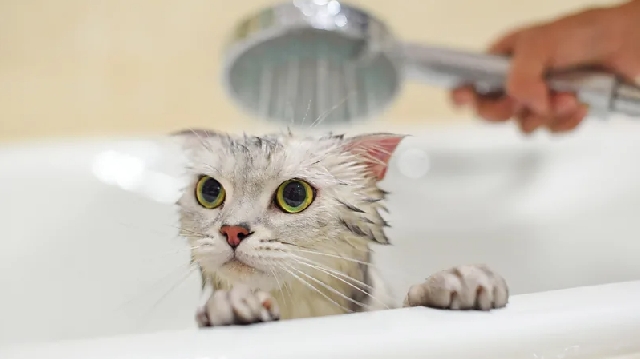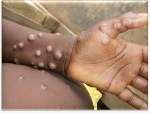How your pets alter your immune system
 Getty Images (Pic): Living in close contact with animals may help to train the immune system by exposing it to a wide variety of microbes
Getty Images (Pic): Living in close contact with animals may help to train the immune system by exposing it to a wide variety of microbes
Living with animals is thought to have profound effects on our immunity – potentially reducing the risk of allergies, eczema and even autoimmune conditions.
Since they first emigrated from Central Europe to North America in the 18th Century, the Amish have become known for their unique lifestyle. Today they are reliant on the same practices of dairy cattle farming and horse-borne transportation that were followed by their ancestors for centuries.
The Amish have gripped the imaginations of Hollywood scriptwriters, documentary makers and sociologists for decades. But in the past 10 years, their way of life has become of increasing interest to the medical world too, as they seem to defy one particularly concerning modern trend. While rates of immune-related conditions which begin in childhood, such as asthma, eczema and allergies, have soared since the 1960s, this has not been the case for the Amish.
The reason for this is revealing insights into how our immune systems operate – and the profound ways that the animals in our lives are affecting them.
A diverse community
To try and understand why the Amish have lower rates of certain immune conditions, a group of scientists spent time back in 2012 with an Amish community in the state of Indiana, and with another farming community known as the Hutterites, in South Dakota. In both cases, they took blood samples from 30 children and studied their immune systems in detail.
There are many similarities between the two groups. Like the Amish, the Hutterites also live off the land, have European ancestry, have minimal exposure to air pollution and follow a diet which is low in processed foods. However, their rates of asthma and childhood allergies are between four and six times higher than among the Amish.
One difference between the two communities is that while the Hutterites have fully embraced industrialised farming technologies, the Amish have not, meaning that from a young age, they live in close contact with animals and the plethora of microbes that they carry.
"If you look at an aerial drone photographs of Amish settlements, and compare them with Hutterite communities, the Amish are living on the farm with the animals, whereas the Hutterites live in little hamlets, and the farm could be a few miles away," says Fergus Shanahan, professor emeritus of medicine at University College Cork, Ireland.
In 2016, a team of scientists from the US and Germany published a now-landmark study concluding that Amish children have a lower risk of allergies because of the way their environments shape their immune systems. In particular, the researchers found that the Amish children in their study had more finely tuned so-called regulatory T cells than those from Hutterite backgrounds. These cells help to dampen down unusual immune responses.
When the researchers scanned dust samples collected from the homes of Amish and Hutterite children for signs of bacteria, they found clear evidence that Amish children were being exposed to more microbes, likely from the animals that they lived among.
Around the world, other scientists have been making similar findings. A group of immunologists reported that children growing up on Alpine farms, where cows typically sleep in close proximity to their owners, seemed to be protected against asthma, hayfever and eczema. Other research has found that a child's allergy risk at ages seven to nine seems to decrease proportionally with the number of pets which were present in the home in their early years of life, dubbed the "mini-farm effect".
"It's not a universal cure-all, and every time I give a lecture on this, someone goes, 'Well I grew up on a farm and I've got allergies', but we know that if you grow up physically interacting with farm animals, you have about a 50% reduction in your likelihood of developing asthma or allergies," says Jack Gilbert, a professor at the University of California San Diego who was involved in the Amish study, and also cofounded the American Gut Project – a citizen science project studying how our lifestyles affect our microbiomes. "Even if you just grow up with a dog in your home, you have a 13-14% reduction in risk," he says.
Protective pets
Since the Amish study was first published, the potentially protective effect of interacting with animals during childhood has been the subject of much fascination, with the New York Times even publishing an article asking whether pets are the new "probiotic".
So what's going on? Perhaps unsurprisingly, given the tactile nature of humans and our fondness for stroking and fondling our pets, when we live with animals, microbes from their fur and paws have been shown to end up on our skin – at least temporarily.
This has led to suggestions that the "microbiome" could be colonised by bugs from our pets. This is the collection of vast colonies of microbes that live on our skin, in our mouths and most notably in the gut, which hosts a significant concentration of our body's immune cells. According to Nasia Safdar, an infectious disease professor at the University of Wisconsin in the US, this concept has attracted interest from the pet food industry. The idea would be to develop products marketed as promoting the growth of beneficial bacteria in cats and dogs, which might then be transferred to their owners, she says.
"That angle has been an attractive one for people to fund, because for most of us, it's the human condition that we're interested in," says Safdar. "So what role can the animal play in that?" she asks.
Safdar says she is considering running a study which would involve collecting faecal samples from both pets and their human owners when they come for repeated veterinary appointments to see if their guts become more microbially similar with time. She also wants to see if she can identify similar bacterial species which could confer health benefits.
However, others feel that the idea of dog or cat or any other kind of non-human animal microbes being incorporated into our microbiomes is dubious. "There's zero evidence of that whatsoever," says Gilbert. "We don't really find long-term accumulation of dog bacteria on our skin, in our mouth, or in our guts. They don't really stick around."
In response to this, Safdar says that she still feels the study is very much worthwhile, stating she feels it is plausible that gut microbes can be transferred from pets to their owners and vice versa. "It's worth studying and hasn't been closely looked at yet," she says.
Gilbert believes that pets are playing a different, yet equally vital role. His theory is that because our distant ancestors domesticated various species, our immune systems have evolved to be stimulated by the microbes that they carry. These microbes do not reside with us permanently, but our immune cells recognise the familiar signals as they pass through, which then keeps the immune system developing in the right way.
"Over many millennia, the human immune system got used to seeing dog, horse and cow bacteria," says Gilbert. "And so when it sees those things, it triggers beneficial immune development. It knows what to do," he says.
Studies have also shown that humans who live in the same household as a pet end up with gut microbiomes which are more like each other, and Gilbert suggests that the animal is likely acting as a vehicle to help transfer human microbes between its owners. At the same time, regular exposure to the pet's own microbes will also be stimulating their immune systems to stay more active and better manage the bacterial populations in their own gut and skin microbiomes, keeping pathogens out and stimulating the growth of useful bacteria.
Ancient microbes
This is all good news for animal lovers, with research continuing to suggest that living with pets across our life course can be good for our immune system.
After reading the study on the Amish and the Hutterites, Shanahan was inspired to conduct his own research on Irish travellers, a marginalised population who typically live in confined spaces amongst multiple animals – from dogs and cats to ferrets and horses.
Shanahan sequenced their gut microbiomes and compared them with Irish people living more modern lifestyles today, as well as microbiomes sequenced from indigenous populations in Fiji, Madagascar, Mongolia, Peru and Tanzania who still live a lifestyle akin to our hunter-gatherer ancestors. He discovered that the microbiome of Irish travellers was more similar to the indigenous groups. He said that their microbiome also bore similarities to that of humans from the pre-industrialised world, which other scientific groups have been able to study by collecting ancient faecal samples preserved in caves.
"The Irish travellers have retained an ancient microbiome," says Shanahan. "It's far more similar to what you see from tribes in Tanzania who still live like hunter-gatherers or the Mongolian horseman who live in yurts, close to their animals."
Shanahan believes that this may explain the low rates of autoimmune diseases in Irish traveller populations: conditions like inflammatory bowel disease, Crohn's disease, ulcerative colitis, multiple sclerosis and other diseases, which like asthma and allergies, have become increasingly common in recent decades.
"This isn't to say that their health is good," says Shanahan. "Irish travellers are dying much earlier than the settled community. But they're dying from things like alcoholism, suicide and accidents, driven by poverty and marginalisation and their culture being eroded. But go to an Irish rheumatologist and ask if they've ever seen a traveller with systemic lupus [an autoimmune condition], they've never seen it."
Now researchers are looking to see whether introducing animals back into our lives in various ways can be beneficial for our health across the life course. Researchers at the University of Arizona in the US have explored whether rehoming unwanted dogs with older adults could help to improve their physical and mental health by boosting their immune systems. And results from an Italian research group which created an educational farm where children from homes with no pets could regularly pet horses under supervision suggested that the children's gut microbiomes started to produce more beneficial metabolites.
Gilbert says it's plausible that this could be a means of improving childhood immunity. "If you're exposed to more types of bacteria, you are going to stimulate your immune system in more variable ways, which may then improve its ability to manage the microbes on your skin and in your gut," he says. "But you're not being colonised by animal bacteria, that's not happening."
Researchers point out that having pets throughout your life can also facilitate more microbial interactions with your immune system in other ways. For example, having a dog makes you more likely to go for regular walks, notes Liam O'Mahoney, professor of immunology at APC Microbiome Ireland, a microbiome-dedicated research centre at University College Cork.
"If you have a pet, you get out and about in the environment and go for walks in the park," says O'Mahoney. "And by doing that, you're also being exposed to microbes from the park, the soil, everywhere which can all be useful."
Source: bbc.com
Trending News

Eyewitness disputes AG’s $7m claim in Adu-Boahene trial
13:31
Accra marks 10th anniversary of June 3rd disaster with climate summit and citywide clean-up today
06:25
GA/R: Ablekuma West MP inspects gutter dredging project to tackle flooding in Dansoman
09:49
MPox virus can last in sperm for six months- Nurse reveals
13:25
FNBSPH-UHAS trains journalists on nutrition, public health to drive change through media advocacy
01:31
Said Sinare caught in a victory that has forgoten him- NPP's Rashid Salifu mocks
09:31
”I almost gave up” Amenfi Central MP opens up about emotional struggle ahead of election victory
13:15
Mahama: Illegal miners removed from eight forest reserves as gov’t steps up sustainable mining reforms
13:44
Deputy Attorney-General confirms serious criminal probe against Chairman Wontumi
07:12
Western Region grapples with Mpox outbreak: A growing concern
13:01




